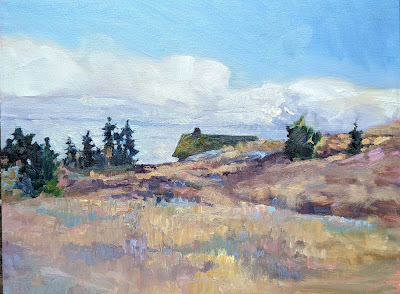How can you get the most from a workshop or class? Here are some simple suggestions.
 |
| Early Spring, Beech Hill, 12X16, oil on canvas board, $1449 framed. |
I’ve been to enough beauty spots in this world that few really astonish me, but the red rocks of Sedona managed it. Brilliant cliffs and spires of sculpted sandstone soar directly above the town. After seeing a dozen or so sites, I turned to my monitor, Ed Buonvecchio, and said, “It’s all wonderful.”
I’m here to teach the first workshop of my season, and it feels great to be out of the cool damp of the northeast, although the temperature there is steadily rising. I’ll be going home to spring painting and it’s time to get prepared.
 |
| Lupines and woods, 8X10, oil on canvasboard, $522 unframed. |
How can you get the most from a workshop or class? Here are some simple suggestions:
Study the supply list.
Note that I didn’t say, “run right out and buy everything on it.” Every teacher has a reason for asking for specific materials. In my case, it’s that I teach a system of paired primaries. You can’t understand color theory without the right starting pigments. Another teacher might have beautiful mark-making. If you don’t buy the brushes he suggests, how are you going to understand his technique?
A tube of cadmium green that I once bought for a workshop and never opened still rankles. I never want to do that to one of my students. When you study with me, I want you to read my supply lists. If something confuses you, or you think you already have a similar item, email and ask.
 |
| Spring Greens, 8X10, oil on canvasboard, is available through the Rye Arts Center. |
Bring the right clothes.
I’d forgotten that I didn’t have enough warm-weather painting clothes to take to Arizona; I retired most at the end of last year. It was warm in Phoenix but just 50° in Sedona yesterday. That means a variety of clothing, because you’ll be chilled in the evenings but might need shorts and a tee-shirt during the day. Layer, baby, layer.
I send my students a packing list for clothes and personal belongings. If you’re going on the Age of Sail, Shary will send you a different list, meant for a boat. Follow these instructions, especially in the matter of insect repellent and sunscreen. Bugs and skin cancer are, unfortunately, eternal verities.
 |
| End of winter, Wyoming, 8X10, oil on canvasboard, $522 unframed. It will be much warmer when I teach there in September. |
Know what you’re getting into.
“How can you stand this? It’s all so green!” an urban painter once said to me after a week in the Adirondacks.
There are amenities in Sedona, but not in other places I teach. If you’re dependent on your latte macchiato, you may find the wilderness uncomfortable at first. There are compensatory attractions. Last night I listened to a duet sung by a coyote and a domestic dog. It was magical.
Be prepared to get down and dirty.
I’m not talking about the outdoors here, I’m talking about change and growth. I am highly competitive myself, so it’s difficult for me to feel like I’m struggling. However, it’s in challenging ourselves that we make progress. Use your teacher’s method while you’re at the workshop, even if you feel like you’ve stepped back ten years in your development. That’s a temporary problem.
You can disregard what you learn when you go home, or incorporate only small pieces into your technique, but you traveled to be challenged, and you can’t do that if you cling to what you know.
Connect with your classmates
I know painters from all over the US. I met most of them in plein air events. There’s power in those relationships. Exchange email addresses. Keep in contact. Follow them on Instagram or Twitter.
Take good notes.
Listen for new ideas, write down concepts, and above all, ask questions. If your teacher can’t stop and answer them mid-stream, save them for after the demo.












